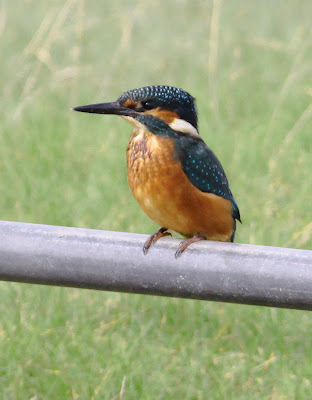The blog title today was nearly “Pinkies and Raptors” to sum up the highlights of a few hours birding at You Know Where, but after a superb morning’s birding filled with action and interest I renamed it to something more fitting.
The “pinkies”, Pink-footed Geese seem to arrive from Iceland earlier each year. There were some flying over the house yesterday afternoon as I cut the lawn for the umpteenth time of this grass-growing-madly year, about 40 geese fairly high in the sky but calling to each other and heading towards South-West Lancashire and the area of Martin Mere.
So I went to Pilling this morning expecting to encounter more pinkies and I wasn’t disappointed, even if it does mean that winter will soon be here. There were about 50 or so out on the distant tideline, with small groups taking off occasionally before climbing and heading south.
Pink-footed Goose
Although the morning sun was up, the wind gusted quite strong from the south, and after seeing yesterday’s virtually zero migration in 100% cloud conditions, in contrast this morning there seemed to be a definite rush of birds and also lots of raptors about. Maybe the raptors had something to do with the release of several hundreds of non-native Red-legged Partridge in recent days, but I’m sure Hi-Fly won’t miss one or two partridge, which would still leave 998 on the loose but destined to be blasted from the sky pretty soon.
Red-legged Partridge - gun fodder
I’d kicked off at Lane Ends with 5 roadside Wheatears, a hovering Kestrel and then Swallows and Meadow Pipits heading into the wind. I wasn’t particularly early at 0800 but the remnants of last night’s roost, 6 Little Egrets and 2 Grey Herons still congregated in the shelter and safety of the island.
As I neared Pilling Water I counted 60 Lapwing and 4 Golden Plover on the wet fields and then from the stile watched as a Peregrine scattered them before it flew back over the wildfowler’s pools where 2 Grey Herons objected noisily to the falcon’s presence but left anyway.
Grey Heron
There was a wary Greenshank feeding on the pool and I got distant views before 2 Buzzards appeared over the trees and scared it off into the less open ditches. The Buzzards saw me, keeping their distance until they flew off in the direction of Fluke Hall.
Greenshank
Buzzard and Carrion Crow
Buzzard
From the gate I watched as 100+ Goldfinch fed along the wall and the edge of the plantation, with a couple of White Wagtails along the shore below. There were enormous numbers of Teal on the pools, roughly 650, with a dozen or so Pintail and I’d gone past looking for the Buzzards before the duck erupted from the ditches, flushed this time by a Marsh Harrier. The harrier kept a distance away, intent on searching the ground and ditches below and it’s another crappy record shot of a “Gold Top”.
Marsh Harrier
There’d been Meadow Pipits and Swallows heading east and by Fluke Hall I’d counted 50+ and 70+ respectively. With some grounded Meadow Pipits I found two newly arrived Wheatears here too, one of them posing for a picture, but when I’d finished the Kingfisher perched on the same rail but further back had by now sped off along the dyke.
Wheatear
The morning wasn’t finished. As I headed back to Lane Ends a Merlin flashed by, low over the marsh and heading out to the tide, but then a few minutes later it or another followed the path of the earlier Peregrine by dashing across the field of Lapwings and scattered them into the sky, calling as they went. What with the Meadow Pipits, Wheatears, Merlin and the pinkies the morning had a definite Icelandic theme, and while they can keep the cold weather their birds are certainly OK.
It’s not a good birding forecast for the week ahead, but with luck there will be more posts soon from Another Bird Blog, so stay tuned.
































































.jpg)












